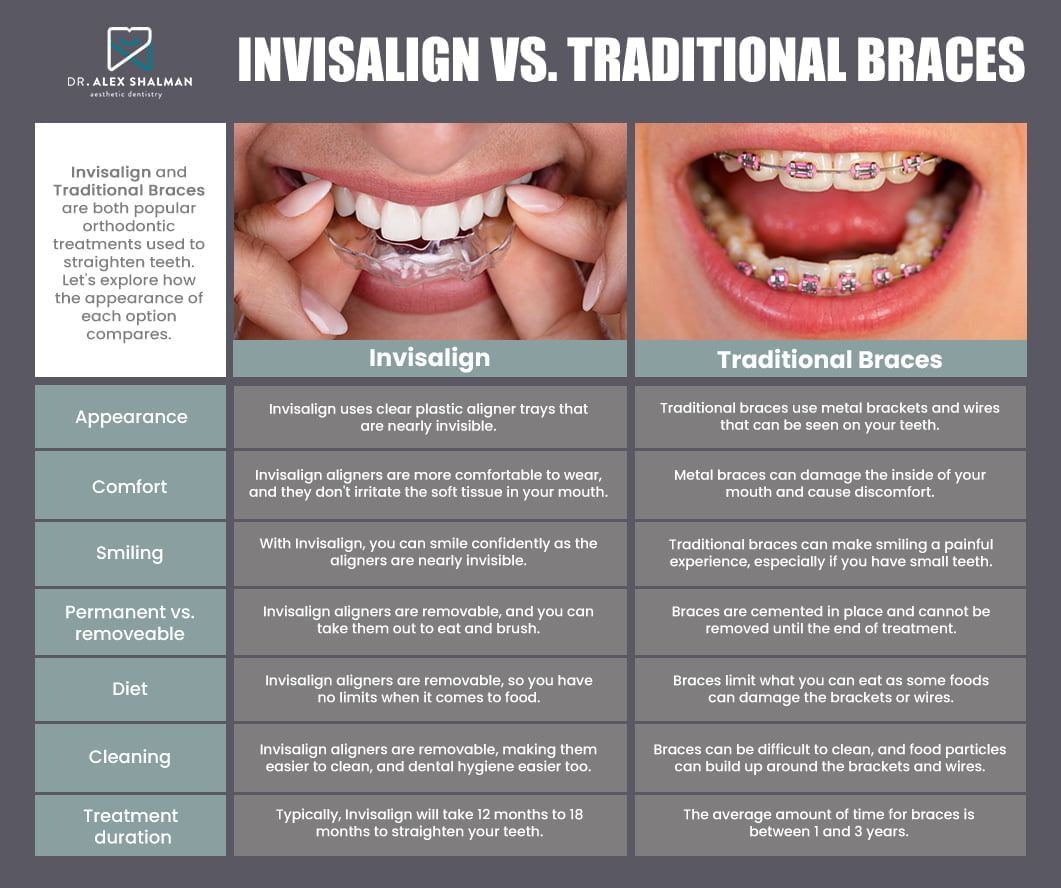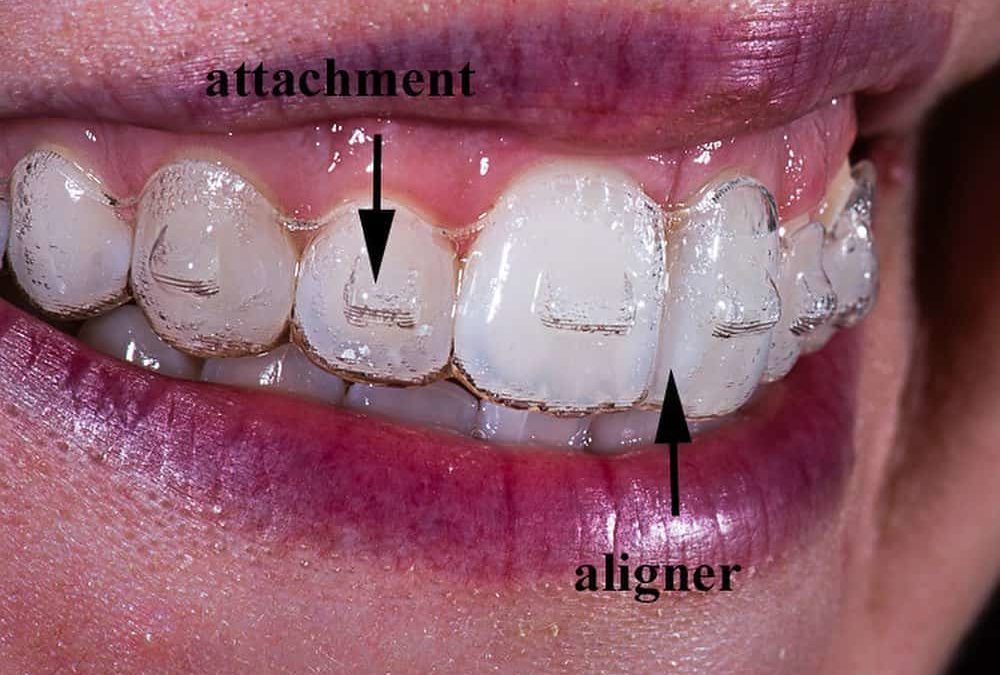Leading Factors to Select Invisalign Over Other Orthodontic Treatments
Wiki Article
Invisalign vs. Typical Braces: Which Choice Is Right for You?
When taking into consideration orthodontic therapy, the option between Invisalign and standard dental braces presents numerous essential aspects that merit mindful assessment. Invisalign supplies a very discreet choice with removable aligners, while standard braces offer an extra noticeable yet effective service for serious misalignment.Review of Therapy Alternatives
In contrast, conventional dental braces include metal braces and cables that are bound to the teeth. This technique uses constant stress in time to attain alignment. While effective for complicated orthodontic problems, traditional braces need routine visits for adjustments and can posture obstacles in keeping oral health due to the trouble of cleansing around brackets and wires.
Both options have their benefits, and the choice commonly rests on certain oral problems, way of life preferences, and person compliance. Inevitably, getting in touch with an orthodontic expert is vital for figuring out one of the most ideal therapy plan tailored to private requirements. Recognizing the subtleties of each alternative can significantly affect the overall success of orthodontic therapy.
Aesthetic Factors To Consider
A considerable factor affecting the selection in between Invisalign and conventional dental braces is the visual appeal each treatment offers. Invisalign aligners are crafted from clear plastic, making them essentially undetectable when worn.On the other hand, typical braces contain metal brackets and cords, which can be much more obvious. While advancements in orthodontic modern technology have actually led to the growth of smaller sized braces and colored elastics, standard braces still preserve a more obvious profile. For some people, the exposure of dental braces might hinder them from looking for required treatment.
Inevitably, the choice between Invisalign and conventional dental braces may rest on personal choices regarding visual appeals. People that focus on discernment frequently lean toward Invisalign, while those who are much less worried about visibility might decide for standard dental braces. Comprehending the visual ramifications of each option is critical for making an educated choice that lines up with one's lifestyle and preferences.
Comfort and Convenience

In terms of ease, Invisalign aligners are detachable, making it possible for individuals to enjoy their favorite foods without limitation and keep optimal oral health. Cleaning and flossing are simplified, as the aligners can be gotten during these routines, whereas conventional dental braces call for cautious maneuvering around wires and braces.
Furthermore, Invisalign's dynamic system allows for less orthodontic visits. Clients usually get several collections of aligners simultaneously, which can simplify the treatment procedure and reduce time invested in the orthodontist's chair. On the other hand, traditional dental visit this website braces demand regular modifications, making them much less practical for those with busy routines. Invisalign. Overall, the comfort and benefit of Invisalign make it an enticing choice for several individuals seeking orthodontic treatment.
Treatment Period and Effectiveness
While both Invisalign and conventional braces are efficient in correcting dental imbalances, the period of treatment can differ dramatically in between both choices. Typically, Invisalign treatment can take anywhere from 12 to 18 months, depending upon the intricacy of the instance. The clear aligners function by gradually shifting teeth into their preferred positions, and normal follow-ups with an orthodontist help ensure progression continues to be on the right track.
In comparison, standard braces usually call for a longer dedication, usually ranging from 18 months to 3 years. This results from their fixed nature and making use of braces and wires, which can be extra effective for serious misalignments and complicated instances (Invisalign). The therapy performance of traditional braces is well-documented, as they permit precise adjustments and greater control over tooth motion
Ultimately, the choice between Invisalign and typical dental braces might rest on both the expected treatment duration and the particular dental problems at hand. Consulting with an orthodontist is important, as they can supply tailored suggestions based on specific demands, making sure the chosen method aligns with wanted end results and durations.
Price Comparison and Insurance Coverage Choices
Price plays a substantial function in the decision-making procedure for individuals considering orthodontic treatment, whether deciding for Invisalign or standard dental braces. Usually, the price of Invisalign ranges from $3,000 to $8,000, while typical braces generally set you back between this link $2,000 and $6,000. Factors affecting these prices consist of the complexity of the case, the duration of treatment, and geographical area.Lots of dental insurance coverage strategies give partial insurance coverage for orthodontic treatments, but the specifics can vary widely. Normally, typical braces may be a lot more frequently covered by insurance coverage plans contrasted to Invisalign, which some insurance providers categorize as a cosmetic procedure.
Furthermore, numerous orthodontic practices supply flexible layaway plan, making both treatment choices a lot more available. People need to inquire concerning potential funding alternatives and discount rates for upfront settlements. Evaluating the total price, consisting of insurance policy advantages and layaway plan, is important for making an informed decision that straightens with both visual choices and budget plan factors to consider.

Conclusion
In recap, the choice between Invisalign and standard braces hinges on multiple factors, including visual preferences, convenience, treatment period, and expense. Invisalign supplies a very discreet, detachable alternative that promotes dental health and dietary adaptability, while conventional dental braces web link may be better for complicated dental problems and frequently come with a lower cost point. Inevitably, consultation with an orthodontist is vital to analyze individual conditions and identify the most proper therapy choice for attaining ideal oral positioning.When considering orthodontic therapy, the option between Invisalign and typical dental braces offers numerous vital factors that warrant cautious assessment.Contrasting Invisalign and traditional dental braces exposes unique therapy options for orthodontic modification.While both Invisalign and typical braces are efficient in dealing with oral imbalances, the period of treatment can differ substantially between the two options.Price plays a considerable role in the decision-making process for individuals taking into consideration orthodontic therapy, whether opting for Invisalign or typical dental braces.In summary, the choice in between Invisalign and traditional dental braces hinges on numerous variables, including visual choices, convenience, therapy period, and price.
Report this wiki page